|
Location:
Dordoigne,
Montignac, France. |
Grid Reference:
N 45� 3' 27", E 1� 10' 12". |
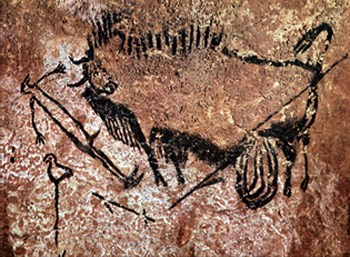
 Lascaux Cave:
(Palaeolithic Cave-art).
Lascaux Cave:
(Palaeolithic Cave-art).
Lascaux contains some
of the best-known Upper Palaeolithic art. These paintings are
estimated to be around 17,300 years old.
(1)
They primarily consist of primitive
images of large animals, most of which are now known from fossil
evidence to have lived in the area at the time.
Lascaux is one of the worlds
richest examples of cave-art with over 1,500 engravings and
600 drawings having been documented. The V�z�re valley in which
Lascaux is found contains 147
prehistoric sites dating from the Palaeolithic and 25 decorated
caves. (1)
(Virtual
Tour of Lascaux Caves)
(Map
of Lascaux Interior Layout)
In addition to the painted images, Lascaux is rich with
engravings of animals as well as abstract designs. It has
long been argued that in the
absence of natural light, these works could only have been
created with the aid of torches and stone lamps filled with
animal fat, however new research has suggested that the
parts of the caves might have been temporarily illuminated
by the sun at certain times of the year (see below).
There are
various theories on the significance of the paintings: Some
people believe them to be records of real life events, others an astro-mythical representation of the night skies, and there are
those that believe them to be 'Shamanic offerings' or 'Hunt
Magic' (6). Perhaps a
little of each may be true. Today, we are left to marvel at
their skilful execution and artistic beauty
It has been suggested that the art represents moments from real life
such as hunts which were drawn on the wall like a comic strip.
(The story of the hunt goes from the left to the right, until the
prey is captured). We can assume from their large number that the
society from which the artist(s) came from tolerated people painting
walls while others hunted or made weapons for the hunters.
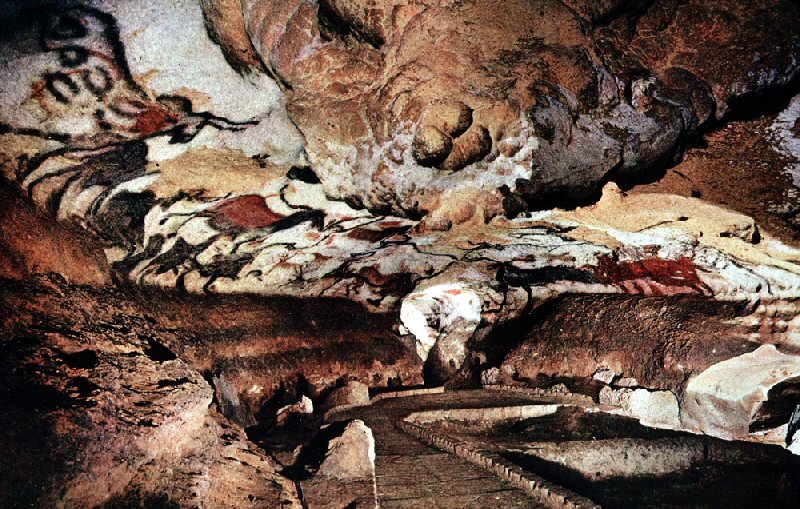
The Main Hall.
At Lascaux and
Chauvet, another magnificently painted cave in France,
images of animals are superimposed on top of earlier
depictions, which suggests that the motivation for the
paintings may have been in the act of portraying the animals
rather than in the artistic effect of the final composition.
However, their purpose remains obscure. Most of the
paintings are located at a distance from the cave's
entrance, and many of the chambers are not easily
accessible. This placement, together with the enormous size
and compelling grandeur of the paintings, suggests that the
remote chambers may have served as sacred or ceremonial
meeting places.
The Lascaux Planetarium.
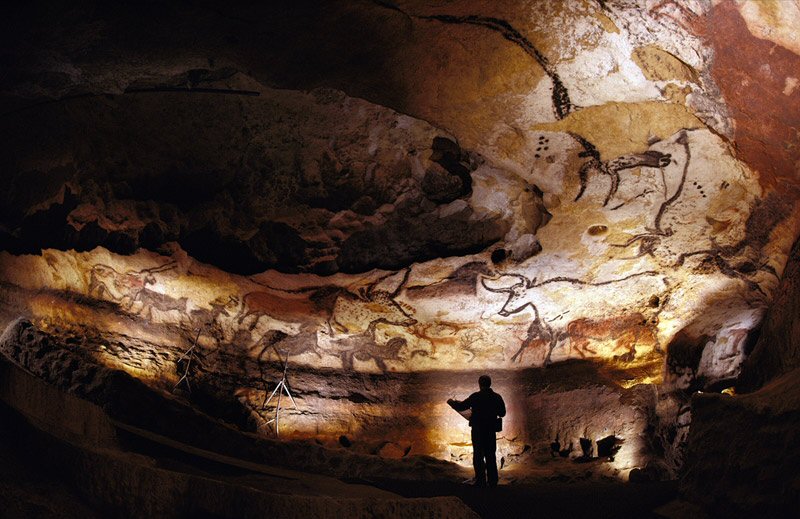
Hall of the
Bulls.
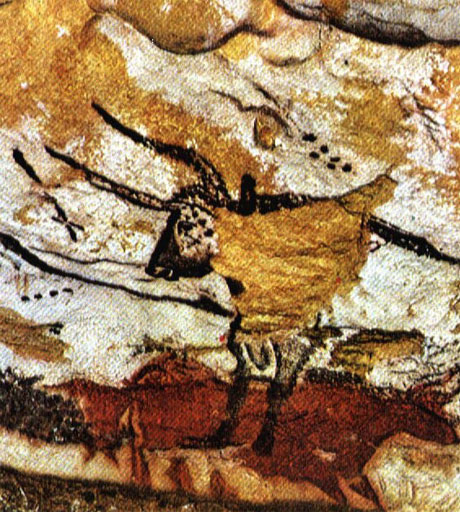 In
recent years, new research has suggested that the Lascaux
paintings may incorporate prehistoric star charts. Dr
Michael Rappenglueck of the University of Munich argued that
some of the non-figurative dot clusters and dots within some
of the figurative images correlate with the constellations
of Taurus, The Pleiades and the grouping known as the
"Summer Triangle". (2)
Based on her own study of the astronomical significance of
Bronze Age petroglyphs in the Vall�e des Merveilles and her
extensive survey of other prehistoric cave painting sites in
the region � most of which appear to have been specifically
selected because the interiors are illuminated by the
setting sun on the day of the winter solstice � French
researcher Chantal J�gues-Wolkiewiez has further proposed
that the gallery of figurative images in the Great Hall
represents an extensive star map and that key points on
major figures in the group correspond to stars in the main
constellations as they appeared in the Palaeolithic.
(3) In
recent years, new research has suggested that the Lascaux
paintings may incorporate prehistoric star charts. Dr
Michael Rappenglueck of the University of Munich argued that
some of the non-figurative dot clusters and dots within some
of the figurative images correlate with the constellations
of Taurus, The Pleiades and the grouping known as the
"Summer Triangle". (2)
Based on her own study of the astronomical significance of
Bronze Age petroglyphs in the Vall�e des Merveilles and her
extensive survey of other prehistoric cave painting sites in
the region � most of which appear to have been specifically
selected because the interiors are illuminated by the
setting sun on the day of the winter solstice � French
researcher Chantal J�gues-Wolkiewiez has further proposed
that the gallery of figurative images in the Great Hall
represents an extensive star map and that key points on
major figures in the group correspond to stars in the main
constellations as they appeared in the Palaeolithic.
(3)
Near to the entrance of the Lascaux
cave complex is a magnificent painting of a bull. Hanging over its
shoulder is what appears (to us) to be a map of the Pleiades, the
cluster of stars sometimes called the Seven Sisters. Inside the bull
painting, there are also indications of spots that may be a
representation of other stars found in that region of sky. Today,
this region forms part of the constellation of Taurus the bull, with
the remarkable suggestion of a direct transfer of information for
over 17,000 years.
�At Lascaux in
15,300 B.C. the
Pleiades were
very near the
point of the
autumn equinox
(: 12h, : 0�),
when we consider
the relation to
the position of
the
brightest
star
25 � Tau (Alcyone;
2m.9, : 12h
16.6m, : +2�
51�). That means
that the
distance
separating the
two was the
equivalent of
only 5.5 times
the width of the
moon, that is
only 2.8� away
from the
equinoctial
point. Even
better is the
star 27 � Tau
(Atlas; 3m.6, :
12h 17.8m, : +2�
34�). This star
reached its
smallest
distance of 2.6�
at the time of
15300BC. Only
[one] hundred
years earlier or
later the
distance was
already larger.�
�The six
stars in the
Salle des
Taureaux
therefore
represent a
striking and
excellent
heavenly marker
for the
beginning of
autumn and of
spring. The
epoch calculated
astronomically
lies
extraordinarily
close to the
uncalibrated
oldest carbon
fourteen dating:
17,190 � 140
radiocarbon
years (with the
reference point
being 1950) and
17300
astronomical
years (in
reference to the
year 2000),
corresponding to
15,300 BC. The
difference is
minimal even if
the margin of
error of the
astronomical
calculation is
taken as being �
500 years.�
(7)
Confirmation that
the art might have been representative of astronomy comes in the
knowledge that the cave opening was orientated towards the sunset on
the summer solstice. This would have naturally raised awareness of
the movement of the
sun over its annual
cycle.
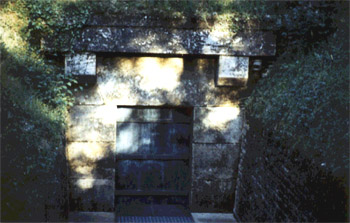
Lascaux cave
entrance on the
summer solstice
sunset. (Photo
Credits: Jacques
Wolkiewiez)

The plan and
section of the entrance to the cave show that before the landslide
had blocked the entrance, at sunset on the summer solstice, the sun
illuminated the inside of the cave. In 1999, the curator of Lascaux
and others witnessed the event for the first time in over 15,000
years. The sunlight entered the cave for approximately 50 minutes
and was bright enough to work by for almost an hour for a few days
of the year. They also calculated that the light of the full-moon
would enter the cave directly on the morning of the winter solstice.
(8)
(More
about Archaeoastronomy)
Geometric Shapes:
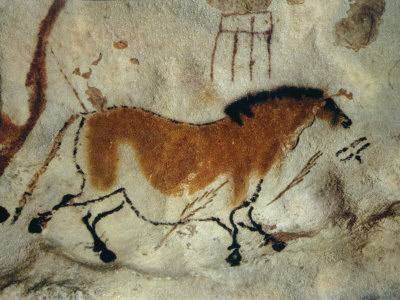
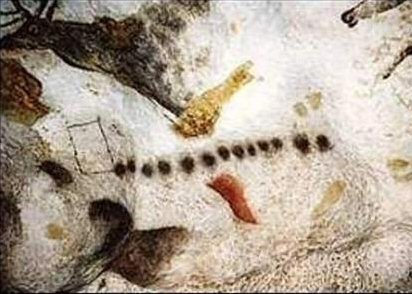
The cave also features hundreds of "signs",
quadrilateral shapes and dots and other patterns which we'll surely never
decipher. They suggest the first inklings of a realisation of
mathematics.
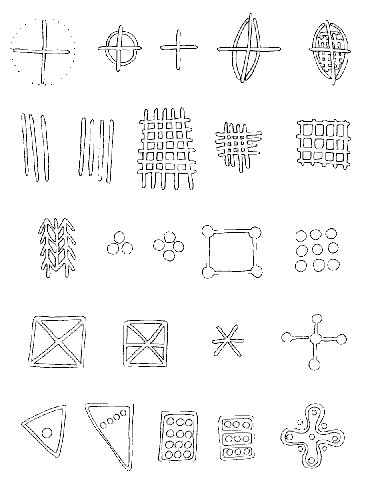
Geometric rock incisions from the
Paleolithic and Mesolithic period.
Mouldy Old
Lascaux.
The carbon
dioxide produced by the breathing of thousands of visitors
(up to 1800 per day at one time)
(4),
the presence of lighting and changes in air circulation have
created a number of problems inside Lascaux. In the late
1950s appearance of lichens and crystals on the walls led to
closure of the caves in 1963. This led to restriction of
access to the real caves to a few vistors every week and the
creation of a replica cave for visitors to Lascaux. In 2001,
the authorities in charge of Lascaux changed the air
conditioning system which resulted in regulation of the
temperature and humidity. When the system had been
established, an infestation of Fusarium solani, a
white mould, began spreading rapidly across the cave ceiling
and walls. (4)
The mould is considered to
have been present in the cave soil and exposed by the
working of tradesmen, leading to the spread of the fungus
which was treated with quicklime. Since 2007, a new fungus,
which has created grey and black blemishes, has begun
spreading in the real cave.
After World
War II, the small cave was opened to the
public and, at one point, it was receiving
as many as 1,800 visitors per day. But by
the late 1950s, the visitors� breath was
blamed for the appearance of lichen and
small crystals on the walls, prompting the
government to close Lascaux to the public in
1963.
Since then,
only five people per day, five days a week,
have been allowed to visit the underground
gallery by special permission, and tourists
are steered into a replica of the cave
complex nearby. The replica, known as
Lascaux II, opened in 1983 and now draws
more than 250,000 tourists each year.
'Recent research on
Lascaux has included
some investigations of
the hundreds of bacteria
which have formed in the
cave. Because it was air
conditioned for decades,
and then treated
biochemically to reduce
mould, many pathogens
have made a home in the
cave, including the
bacillus for
Legionnaire's disease.
It is unlikely that the
cave will ever be opened
to the public again...'.
(So what can you do about
it?...
Get Involved Here )
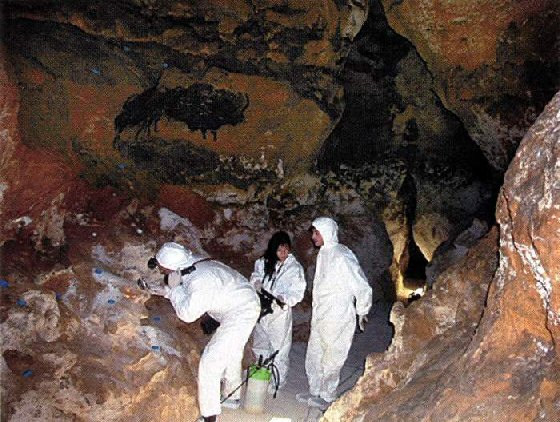
Cleaning
off the white mould on the wall of Lascaux.
(Photo Credits:
http://www.donsmaps.com)
Lascaux II.
Opened in 1983, Lascaux II was the result of eleven years'
painstaking work by twenty artists and sculptors, under the
supervision of Monique Peytral, using the same methods and materials
as the original cave painters. This is what almost everyone gets to
see today.
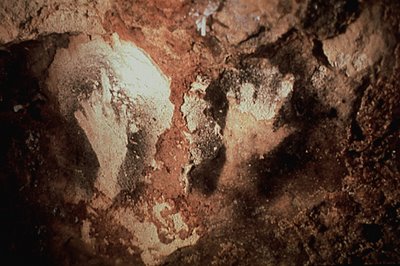 Mutilated Hands. Mutilated Hands.
At least 20 caves
in France and Spain show evidence of 'mutilated' hands. In Lascaux,
accidental prints of mutilated hands left in clay and now hardened
by calcite have been discovered, proving that their hands were
indeed mutilated (although the cause is unknown). The Grotte de
Gargas in France where 231 outlines off hands were found on the
walls, of which over half were mutilated. It is tentatively
suggested that because of the remaining thumbs on all the hands,
frostbite might be involved.
(5)
Photo Gallery: Lascaux.
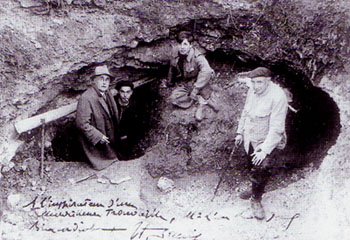
The entrance to
Lascaux caves, 1940.
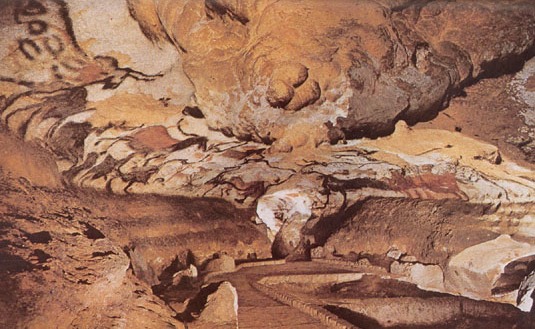
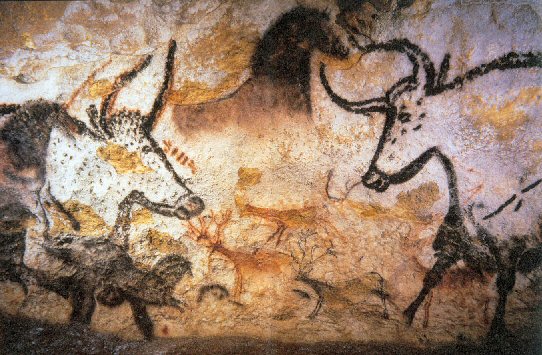
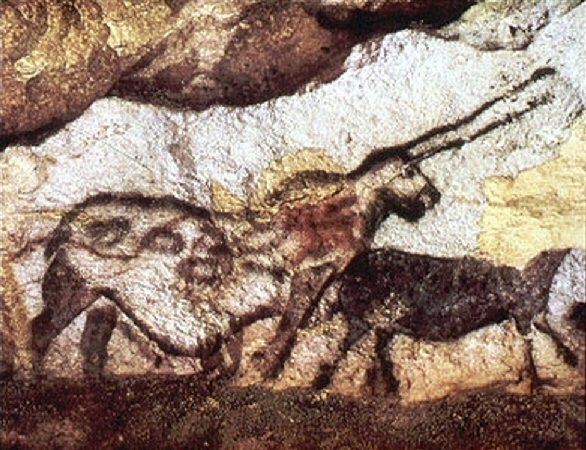
(Prehistoric Cave-art)
(Other Prehistoric
French Sites)
|




 In
recent years, new research has suggested that the Lascaux
paintings may incorporate prehistoric star charts. Dr
Michael Rappenglueck of the University of Munich argued that
some of the non-figurative dot clusters and dots within some
of the figurative images correlate with the constellations
of Taurus, The Pleiades and the grouping known as the
"Summer Triangle". (2)
Based on her own study of the astronomical significance of
Bronze Age petroglyphs in the Vall�e des Merveilles and her
extensive survey of other prehistoric cave painting sites in
the region � most of which appear to have been specifically
selected because the interiors are illuminated by the
setting sun on the day of the winter solstice � French
researcher Chantal J�gues-Wolkiewiez has further proposed
that the gallery of figurative images in the Great Hall
represents an extensive star map and that key points on
major figures in the group correspond to stars in the main
constellations as they appeared in the Palaeolithic.
(3)
In
recent years, new research has suggested that the Lascaux
paintings may incorporate prehistoric star charts. Dr
Michael Rappenglueck of the University of Munich argued that
some of the non-figurative dot clusters and dots within some
of the figurative images correlate with the constellations
of Taurus, The Pleiades and the grouping known as the
"Summer Triangle". (2)
Based on her own study of the astronomical significance of
Bronze Age petroglyphs in the Vall�e des Merveilles and her
extensive survey of other prehistoric cave painting sites in
the region � most of which appear to have been specifically
selected because the interiors are illuminated by the
setting sun on the day of the winter solstice � French
researcher Chantal J�gues-Wolkiewiez has further proposed
that the gallery of figurative images in the Great Hall
represents an extensive star map and that key points on
major figures in the group correspond to stars in the main
constellations as they appeared in the Palaeolithic.
(3)




 Mutilated Hands.
Mutilated Hands.


